Surface Display Technology for Biosensor Applications: A Review
Abstract
1. Introduction
2. Phage Display-Based Biosensors
3. Bacterial Surface Display for Biosensor Applications
3.1. Gram-Negative Bacteria
3.2. Gram-Positive Bacteria
4. Eukaryotic Yeast Cell Surface Display for Biosensor Applications
5. Conclusions and Perspectives
Funding
Conflicts of Interest
References
- Park, M. Orientation Control of the Molecular Recognition Layer for Improved Sensitivity: A Review. BioChip J. 2019, 13, 82–94. [Google Scholar] [CrossRef]
- Pyun, J.; Kim, S.; Chung, J. New immobilization method for immunoaffinity biosensors by using thiolated proteins. Anal. Biochem. 2005, 347, 227–233. [Google Scholar] [CrossRef]
- Turner, A.; Karube, I.; Wilson, G.S. Biosensors: Fundamentals and Applications; Oxford University Press: Hong Kong, China, 1987. [Google Scholar]
- Afzal, A.; Iqbal, N.; Mujahid, A.; Schirhagl, R. Advanced vapor recognition materials for selective and fast responsive surface acoustic wave sensors: A review. Anal. Chim. Acta 2013, 787, 36–49. [Google Scholar] [CrossRef]
- Arnau, A. A review of interface electronic systems for AT-cut quartz crystal microbalance applications in liquids. Sensors 2008, 8, 370–411. [Google Scholar] [CrossRef]
- Tsouti, V.; Boutopoulos, C.; Zergioti, I.; Chatzandroulis, S. Capacitive microsystems for biological sensing. Biosens. Bioelectron. 2011, 27, 1–11. [Google Scholar] [CrossRef]
- Hoa, X.D.; Kirk, A.; Tabrizian, M. Towards integrated and sensitive surface plasmon resonance biosensors: A review of recent progress. Biosens. Bioelectron. 2007, 23, 151–160. [Google Scholar] [CrossRef]
- Putzbach, W.; Ronkainen, N.J. Immobilization techniques in the fabrication of nanomaterial-based electrochemical biosensors: A review. Sensors 2013, 13, 4811–4840. [Google Scholar] [CrossRef]
- Park, M.; Pyun, J.C.; Jose, J. Orientation and density control of proteins on solid matters by outer membrane coating: Analytical and diagnostic applications. J. Pharm. Biomed. Anal. 2018, 147, 174–184. [Google Scholar] [CrossRef]
- Karlsson, R. SPR for molecular interaction analysis: A review of emerging application areas. J. Mol. Recognit. 2004, 17, 151–161. [Google Scholar] [CrossRef]
- Tuantranont, A.; Wisitsora-At, A.; Sritongkham, P.; Jaruwongrungsee, K. A review of monolithic multichannel quartz crystal microbalance: A review. Anal. Chim. Acta 2011, 687, 114–128. [Google Scholar] [CrossRef]
- Suhito, I.R.; Angeline, N.; Kim, T.-H. Nanomaterial-modified hybrid platforms for precise electrochemical detection of dopamine. BioChip J. 2019, 13, 20–29. [Google Scholar] [CrossRef]
- Lee, S.; Choi, I. Fabrication Strategies of 3D Plasmonic Structures for SERS. BioChip J. 2019, 13, 30–42. [Google Scholar] [CrossRef]
- Liu, Q.; Wang, J.; Boyd, B.J. Peptide-based biosensors. Talanta 2015, 136, 114–127. [Google Scholar] [CrossRef]
- Mross, S.; Pierrat, S.; Zimmermann, T.; Kraft, M. Microfluidic enzymatic biosensing systems: A review. Biosens. Bioelectron. 2015, 70, 376–391. [Google Scholar] [CrossRef]
- Yousefi, M.; Dehghani, S.; Nosrati, R.; Zare, H.; Evazalipour, M.; Mosafer, J.; Tehrani, B.S.; Pasdar, A.; Mokhtarzadeh, A.; Ramezani, M. Aptasensors as a new sensing technology developed for the detection of MUC1 mucin: A review. Biosens. Bioelectron. 2019, 130, 1–19. [Google Scholar] [CrossRef]
- Felix, F.S.; Angnes, L. Electrochemical immunosensors—A powerful tool for analytical applications. Biosens. Bioelectron. 2018, 102, 470–478. [Google Scholar] [CrossRef]
- Wang, W.; Chen, C.; Qian, M.; Zhao, X.S. Aptamer biosensor for protein detection using gold nanoparticles. Anal. Biochem. 2008, 373, 213–219. [Google Scholar] [CrossRef]
- Rishpon, J.; Ivnitski, D. An amperometric enzyme-channeling immunosensor. Biosens. Bioelectron. 1997, 12, 195–204. [Google Scholar] [CrossRef]
- Sung, J.H.; Koo, J.; Shuler, M.L. Mimicking the Human Physiology with Microphysiological Systems (MPS). BioChip J. 2019, 13, 115–126. [Google Scholar] [CrossRef]
- Lewis, R.; Barrett-Jolley, R. Changes in membrane receptors and ion channels as potential biomarkers for osteoarthritis. Front. Physiol. 2015, 6, 357. [Google Scholar] [CrossRef]
- Kondo, A.; Ueda, M. Yeast cell-surface display—applications of molecular display. Appl. Microbiol. Biotechnol. 2004, 64, 28–40. [Google Scholar] [CrossRef]
- Cho, W.; Stahelin, R.V. Membrane-protein interactions in cell signaling and membrane trafficking. Annu. Rev. Biophys. Biomol. Struct. 2005, 34, 119–151. [Google Scholar] [CrossRef]
- Benallal, M.; Anner, B.M. Identification of organ-specific glycosylation of a membrane protein in two tissues using lectins. Experientia 1994, 50, 664–668. [Google Scholar] [CrossRef]
- Almén, M.S.; Nordström, K.J.; Fredriksson, R.; Schiöth, H.B. Mapping the human membrane proteome: A majority of the human membrane proteins can be classified according to function and evolutionary origin. BMC Biol. 2009, 7, 50. [Google Scholar] [CrossRef]
- Nakane, Y.; Kubo, I. Layer-by-layer of liposomes and membrane protein as a recognition element of biosensor. Thin Solid Films 2009, 518, 678–681. [Google Scholar] [CrossRef]
- Jose, J.; Maas, R.M.; Teese, M.G. Autodisplay of enzymes—Molecular basis and perspectives. J. Biotechnol. 2012, 161, 92–103. [Google Scholar] [CrossRef]
- Chen, W.; Georgiou, G. Cell-surface display of heterologous proteins: From high-throughput screening to environmental applications. Biotechnol. Bioeng. 2002, 79, 496–503. [Google Scholar] [CrossRef]
- Lee, S.Y.; Choi, J.H.; Xu, Z. Microbial cell-surface display. Trends Biotechnol. 2003, 21, 45–52. [Google Scholar] [CrossRef]
- Grabherr, R.; Ernst, W. The baculovirus expression system as a tool for generating diversity by viral surface display. Comb. Chem. High Throughput Screen. 2001, 4, 185–192. [Google Scholar] [CrossRef]
- Smith, G.P. Filamentous fusion phage: Novel expression vectors that display cloned antigens on the virion surface. Science 1985, 228, 1315–1317. [Google Scholar] [CrossRef]
- Petrenko, V.A.; Vodyanoy, V.J. Phage display for detection of biological threat agents. J. Microbiol. Methods 2003, 53, 253–262. [Google Scholar] [CrossRef]
- Giordano, R.J.; Cardó-Vila, M.; Lahdenranta, J.; Pasqualini, R.; Arap, W. Biopanning and rapid analysis of selective interactive ligands. Nat. Med. 2001, 7, 1249–1253. [Google Scholar] [CrossRef]
- Smith, G.P.; Petrenko, V.A. Phage display. Chem. Rev. 1997, 97, 391–410. [Google Scholar] [CrossRef]
- Bozovičar, K.; Bratkovič, T. Evolving a Peptide: Library Platforms and Diversification Strategies. Int. J. Mol. Sci. 2020, 21, 215. [Google Scholar] [CrossRef]
- Peltomaa, R.; Benito-Peña, E.; Barderas, R.; Moreno-Bondi, M.C. Phage Display in the Quest for New Selective Recognition Elements for Biosensors. ACS Omega 2019, 4, 11569–11580. [Google Scholar] [CrossRef]
- Shi, F.; Gan, L.; Wang, Y.; Wang, P. Impedimetric biosensor fabricated with affinity peptides for sensitive detection of Escherichia coli O157:H7. Biotechnol. Lett. 2020, 42, 825–832. [Google Scholar] [CrossRef]
- Wu, J.; Cropek, D.M.; West, A.C.; Banta, S. Development of a troponin I biosensor using a peptide obtained through phage display. Anal. Chem. 2010, 82, 8235–8243. [Google Scholar] [CrossRef]
- Wu, J.; Park, J.P.; Dooley, K.; Cropek, D.M.; West, A.C.; Banta, S. Rapid development of new protein biosensors utilizing peptides obtained via phage display. PLoS ONE 2011, 6, e24948. [Google Scholar] [CrossRef]
- Liu, P.; Han, L.; Wang, F.; Petrenko, V.A.; Liu, A. Gold nanoprobe functionalized with specific fusion protein selection from phage display and its application in rapid, selective and sensitive colorimetric biosensing of Staphylococcus aureus. Biosens. Bioelectron. 2016, 82, 195–203. [Google Scholar] [CrossRef]
- Lee, K.Y.; Byeon, H.H.; Jang, C.; Choi, J.H.; Choi, I.S.; Jung, Y.; Kim, W.; Chang, J.; Yi, H. Hydrodynamic Assembly of Conductive Nanomesh of Single-Walled Carbon Nanotubes Using Biological Glue. Adv. Mater. 2015, 27, 922–928. [Google Scholar] [CrossRef]
- Lee, S.W.; Lee, K.Y.; Song, Y.W.; Choi, W.K.; Chang, J.; Yi, H. Direct electron transfer of enzymes in a biologically assembled conductive nanomesh enzyme platform. Adv. Mater. 2016, 28, 1577–1584. [Google Scholar] [CrossRef]
- Nanduri, V.; Sorokulova, I.B.; Samoylov, A.M.; Simonian, A.L.; Petrenko, V.A.; Vodyanoy, V. Phage as a molecular recognition element in biosensors immobilized by physical adsorption. Biosens. Bioelectron. 2007, 22, 986–992. [Google Scholar] [CrossRef] [PubMed]
- Nanduri, V.; Bhunia, A.K.; Tu, S.-I.; Paoli, G.C.; Brewster, J.D. SPR biosensor for the detection of L. monocytogenes using phage-displayed antibody. Biosens. Bioelectron. 2007, 23, 248–252. [Google Scholar] [CrossRef] [PubMed]
- Park, J.P.; Cropek, D.M.; Banta, S. High affinity peptides for the recognition of the heart disease biomarker troponin I identified using phage display. Biotechnol. Bioeng. 2010, 105, 678–686. [Google Scholar] [CrossRef] [PubMed]
- Paoli, G.C.; Chen, C.-Y.; Brewster, J.D. Single-chain Fv antibody with specificity for Listeria monocytogenes. J. Immunol. Methods 2004, 289, 147–155. [Google Scholar] [CrossRef]
- Georgiou, G.; Stathopoulos, C.; Daugherty, P.S.; Nayak, A.R.; Iverson, B.L.; Curtiss, R., 3rd. Display of heterologous proteins on the surface of microorganisms: From the screening of combinatorial libraries to live recombinant vaccines. Nat. Biotechnol. 1997, 15, 29–34. [Google Scholar] [CrossRef]
- Little, M.; Fuchs, P.; Breitling, F.; Dübel, S. Bacterial surface presentation of proteins and peptides: An alternative to phage technology? Trends Biotechnol. 1993, 11, 3–5. [Google Scholar] [CrossRef]
- van Bloois, E.; Winter, R.T.; Kolmar, H.; Fraaije, M.W. Decorating microbes: Surface display of proteins on Escherichia coli. Trends Biotechnol. 2011, 29, 79–86. [Google Scholar] [CrossRef]
- Maurer, J.; Jose, J.; Meyer, T.F. Autodisplay: One-component system for efficient surface display and release of soluble recombinant proteins from Escherichia coli. J. Bacteriol. 1997, 179, 794–804. [Google Scholar] [CrossRef]
- Ståhl, S.; Uhlén, M. Bacterial surface display: Trends and progress. Trends Biotechnol. 1997, 15, 185–192. [Google Scholar] [CrossRef]
- Sørensen, H.P.; Mortensen, K.K. Soluble expression of recombinant proteins in the cytoplasm of Escherichia coli. Microb. Cell Fact. 2005, 4, 1. [Google Scholar] [CrossRef] [PubMed]
- Löfblom, J. Bacterial display in combinatorial protein engineering. Biotechnol. J. 2011, 6, 1115–1129. [Google Scholar] [CrossRef] [PubMed]
- Coico, R. Gram staining. Curr. Protoc. Microbiol. 2006, 1, A.3C.1–A.3C.2. [Google Scholar] [CrossRef]
- Saleem, M.; Brim, H.; Hussain, S.; Arshad, M.; Leigh, M. Perspectives on microbial cell surface display in bioremediation. Biotechnol. Adv. 2008, 26, 151–161. [Google Scholar] [CrossRef] [PubMed]
- Xu, Z.; Lee, S.Y. Display of Polyhistidine Peptides on theEscherichia coli Cell Surface by Using Outer Membrane Protein C as an Anchoring Motif. Appl. Environ. Microbiol. 1999, 65, 5142–5147. [Google Scholar] [CrossRef]
- Lång, H. Outer membrane proteins as surface display systems. Int. J. Med. Microbiol. 2000, 290, 579–585. [Google Scholar] [CrossRef]
- Klemm, P.; Schembri, M.A. Fimbriae assisted bacterial surface display of heterologous peptides. Int. J. Med. Microbiol. 2000, 290, 215–221. [Google Scholar] [CrossRef]
- Westerlund-Wikström, B. Peptide display on bacterial flagella: Principles and applications. Int. J. Med. Microbiol. 2000, 290, 223–230. [Google Scholar] [CrossRef]
- De Keyzer, J.; Van Der Does, C.; Driessen, A. The bacterial translocase: A dynamic protein channel complex. Cell. Mol. Life Sci. 2003, 60, 2034–2052. [Google Scholar] [CrossRef]
- Park, M.; Pyun, J.C.; Akter, H.; Nguyen, B.T.; Kang, M.J. Evaluation of a specific diagnostic marker for rheumatoid arthritis based on cyclic citrullinated peptide. J. Pharm. Biomed. Anal. 2015, 115, 107–113. [Google Scholar] [CrossRef][Green Version]
- Mulchandani, A.; Mulchandani, P.; Kaneva, I.; Chen, W. Biosensor for direct determination of organophosphate nerve agents using recombinant Escherichia coli with surface-expressed organophosphorus hydrolase. 1. Potentiometric microbial electrode. Anal. Chem. 1998, 70, 4140–4145. [Google Scholar] [CrossRef] [PubMed]
- Tang, X.; Zhang, T.; Liang, B.; Han, D.; Zeng, L.; Zheng, C.; Li, T.; Wei, M.; Liu, A. Sensitive electrochemical microbial biosensor for p-nitrophenylorganophosphates based on electrode modified with cell surface-displayed organophosphorus hydrolase and ordered mesopore carbons. Biosens. Bioelectron. 2014, 60, 137–142. [Google Scholar] [CrossRef] [PubMed]
- Liang, B.; Li, L.; Tang, X.; Lang, Q.; Wang, H.; Li, F.; Shi, J.; Shen, W.; Palchetti, I.; Mascini, M. Microbial surface display of glucose dehydrogenase for amperometric glucose biosensor. Biosens. Bioelectron. 2013, 45, 19–24. [Google Scholar] [CrossRef] [PubMed]
- Liang, B.; Zhang, S.; Lang, Q.; Song, J.; Han, L.; Liu, A. Amperometric L-glutamate biosensor based on bacterial cell-surface displayed glutamate dehydrogenase. Anal. Chim. Acta 2015, 884, 83–89. [Google Scholar] [CrossRef] [PubMed]
- Zhang, Z.; Liu, J.; Fan, J.; Wang, Z.; Li, L. Detection of catechol using an electrochemical biosensor based on engineered Escherichia coli cells that surface-display laccase. Anal. Chim. Acta 2018, 1009, 65–72. [Google Scholar] [CrossRef]
- Park, T.J.; Zheng, S.; Kang, Y.J.; Lee, S.Y. Development of a whole-cell biosensor by cell surface display of a gold-binding polypeptide on the gold surface. FEMS Microbiol. Lett. 2009, 293, 141–147. [Google Scholar] [CrossRef]
- Ravikumar, S.; Ganesh, I.; Yoo, I.-K.; Hong, S.H. Construction of a bacterial biosensor for zinc and copper and its application to the development of multifunctional heavy metal adsorption bacteria. Process Biochem. 2012, 47, 758–765. [Google Scholar] [CrossRef]
- Jose, J.; Chung, J.-W.; Jeon, B.-J.; Maas, R.M.; Nam, C.-H.; Pyun, J.-C. Escherichia coli with autodisplayed Z-domain of protein A for signal amplification of SPR biosensor. Biosens. Bioelectron. 2009, 24, 1324–1329. [Google Scholar] [CrossRef]
- Lee, E.-H.; Yoo, G.; Jose, J.; Kang, M.-J.; Song, S.-M.; Pyun, J.-C. SPR biosensor based on immobilized E. coli cells with autodisplayed Z-domains. BioChip J. 2012, 6, 221–228. [Google Scholar] [CrossRef]
- Jose, J.; Park, M.; Pyun, J.C. E. coli outer membrane with autodisplayed Z-domain as a molecular recognition layer of SPR biosensor. Biosens. Bioelectron. 2010, 25, 1225–1228. [Google Scholar] [CrossRef]
- Park, M.; Jose, J.; Pyun, J.-C. SPR biosensor by using E. coli outer membrane layer with autodisplayed Z-domains. Sens. Actuators B Chem. 2011, 154, 82–88. [Google Scholar] [CrossRef]
- Kronqvist, N.; Löfblom, J.; Jonsson, A.; Wernérus, H.; Ståhl, S. A novel affinity protein selection system based on staphylococcal cell surface display and flow cytometry. Protein Eng. Des. Sel. 2008, 21, 247–255. [Google Scholar] [CrossRef] [PubMed]
- Kronqvist, N.; Malm, M.; Göstring, L.; Gunneriusson, E.; Nilsson, M.; Höidén Guthenberg, I.; Gedda, L.; Frejd, F.Y.; Ståhl, S.; Löfblom, J. Combining phage and staphylococcal surface display for generation of ErbB3-specific Affibody molecules. Protein Eng. Des. Sel. 2011, 24, 385–396. [Google Scholar] [CrossRef]
- Richins, R.D.; Kaneva, I.; Mulchandani, A.; Chen, W. Biodegradation of organophosphorus pesticides by surface-expressed organophosphorus hydrolase. Nat. Biotechnol. 1997, 15, 984–987. [Google Scholar] [CrossRef] [PubMed]
- Tang, X.; Liang, B.; Yi, T.; Manco, G.; Palchetti, I.; Liu, A. Corrigendum to “Cell surface display of organophosphorus hydrolase for sensitive spectrophotometric detection of p-nitrophenol substituted organophosphates” [Enzyme Microb. Technol. 55 (2014) 107–112]. Enzyme Microb. Technol. 2014, 60, 80. [Google Scholar] [CrossRef]
- Jose, J.; Meyer, T.F. The autodisplay story, from discovery to biotechnical and biomedical applications. Microbiol. Mol. Biol. Rev. 2007, 71, 600–619. [Google Scholar] [CrossRef]
- Jose, J. Autodisplay: Efficient bacterial surface display of recombinant proteins. Appl. Microbiol. Biotechnol. 2006, 69, 607–614. [Google Scholar] [CrossRef]
- Park, M.; Jose, J.; Thommes, S.; Kim, J.I.; Kang, M.J.; Pyun, J.C. Autodisplay of streptavidin. Enzyme Microb. Technol. 2011, 48, 307–311. [Google Scholar] [CrossRef]
- Jose, J.; Park, M.; Pyun, J.C. Highly sensitive immunoassay based on E. coli with autodisplayed Z-domain. Anal. Chim. Acta 2010, 667, 113–118. [Google Scholar] [CrossRef]
- Nilsson, B.; Moks, T.; Jansson, B.; Abrahmsen, L.; Elmblad, A.; Holmgren, E.; Henrichson, C.; Jones, T.A.; Uhlen, M. A synthetic IgG-binding domain based on staphylococcal protein A. Protein Eng. Design Sel. 1987, 1, 107–113. [Google Scholar] [CrossRef]
- Park, M.; Yoo, G.; Bong, J.H.; Jose, J.; Kang, M.J.; Pyun, J.C. Isolation and characterization of the outer membrane of Escherichia coli with autodisplayed Z-domains. Biochim. Biophys. Acta 2015, 1848, 842–847. [Google Scholar] [CrossRef]
- Park, M.; Jose, J.; Pyun, J.-C. Hypersensitive immunoassay by using Escherichia coli outer membrane with autodisplayed Z-domains. Enzyme Microb. Technol. 2010, 46, 309–314. [Google Scholar] [CrossRef]
- Jeon, D.; Pyun, J.C.; Jose, J.; Park, M. A Regenerative Immunoaffinity Layer Based on the Outer Membrane of Z-Domains Autodisplaying, E. coli for Immunoassays and Immunosensors. Sensors 2018, 18, 4030. [Google Scholar] [CrossRef]
- Shockman, G.D.; Barren, J.F. Structure, function, and assembly of cell walls of gram-positive bacteria. Annu. Rev. Microbiol. 1983, 37, 501–527. [Google Scholar] [CrossRef] [PubMed]
- Ståahl, S.; Robert, A.; Gunneriusson, E.; Wernérus, H.; Cano, F.; Liljeqvist, S.; Hansson, M.; Nguyen, T.N.; Samuelson, P. Staphylococcal surface display and its applications. Int. J. Med. Microbiol. 2000, 290, 571–577. [Google Scholar] [CrossRef]
- Hansson, M.; Samuelson, P.; Gunneriusso, E.; Stahl, S. Surface display on gram positive bacteria. Comb. Chem. High Throughput Screen. 2001, 4, 171–184. [Google Scholar] [CrossRef] [PubMed]
- Fleet, G. Cell walls. In The Yeasts, vol 4. Organelles; Rose, A.H., Harrison, J.S., Eds.; Academic: London, UK, 1991. [Google Scholar]
- Chen, X. Yeast cell surface display: An efficient strategy for improvement of bioethanol fermentation performance. Bioengineered 2017, 8, 115–119. [Google Scholar] [CrossRef]
- Kukuruzinska, M.; Bergh, M.; Jackson, B. Protein glycosylation in yeast. Annu. Rev. Biochem. 1987, 56, 915–944. [Google Scholar] [CrossRef]
- Hamilton, S.R.; Gerngross, T.U. Glycosylation engineering in yeast: The advent of fully humanized yeast. Curr. Opin. Biotechnol. 2007, 18, 387–392. [Google Scholar] [CrossRef]
- Han, L.; Zhao, Y.; Cui, S.; Liang, B. Redesigning of microbial cell surface and its application to whole-cell biocatalysis and biosensors. Appl. Biochem. Biotechnol. 2018, 185, 396–418. [Google Scholar] [CrossRef] [PubMed]
- Kuroda, K.; Ueda, M. Arming technology in yeast—Novel strategy for whole-cell biocatalyst and protein engineering. Biomolecules 2013, 3, 632–650. [Google Scholar] [CrossRef] [PubMed]
- Kuroda, K.; Ueda, M. Generation of arming yeasts with active proteins and peptides via cell surface display system: Cell surface engineering, bio-arming technology. In Yeast Metabolic Engineering; Springer: Berlin/Heidelberg, Germany, 2014; pp. 137–155. [Google Scholar]
- Ye, K.; Shibasaki, S.; Ueda, M.; Murai, T.; Kamasawa, N.; Osumi, M.; Shimizu, K.; Tanaka, A. Construction of an engineered yeast with glucose-inducible emission of green fluorescence from the cell surface. Appl. Microbiol. Biotechnol. 2000, 54, 90–96. [Google Scholar] [CrossRef] [PubMed]
- Shibasaki, S.; Ueda, M.; Ye, K.; Shimizu, K.; Kamasawa, N.; Osumi, M.; Tanaka, A. Creation of cell surface-engineered yeast that display different fluorescent proteins in response to the glucose concentration. Appl. Microbiol. Biotechnol. 2001, 57, 528–533. [Google Scholar] [PubMed]
- Shibasaki, S.; Ninomiya, Y.; Ueda, M.; Iwahashi, M.; Katsuragi, T.; Tani, Y.; Harashima, S.; Tanaka, A. Intelligent yeast strains with the ability to self-monitor the concentrations of intra-and extracellular phosphate or ammonium ion by emission of fluorescence from the cell surface. Appl. Microbiol. Biotechnol. 2001, 57, 702–707. [Google Scholar]
- Shibasaki, S.; Tanaka, A.; Ueda, M. Development of combinatorial bioengineering using yeast cell surface display—order-made design of cell and protein for bio-monitoring. Biosens. Bioelectron. 2003, 19, 123–130. [Google Scholar] [CrossRef]
- Wang, H.; Lang, Q.; Li, L.; Liang, B.; Tang, X.; Kong, L.; Mascini, M.; Liu, A. Yeast surface displaying glucose oxidase as whole-cell biocatalyst: Construction, characterization, and its electrochemical glucose sensing application. Anal. Chem. 2013, 85, 6107–6112. [Google Scholar] [CrossRef]
- Liang, B.; Wang, G.; Yan, L.; Ren, H.; Feng, R.; Xiong, Z.; Liu, A. Functional cell surface displaying of acetylcholinesterase for spectrophotometric sensing organophosphate pesticide. Sens. Actuators B Chem. 2019, 279, 483–489. [Google Scholar] [CrossRef]
- Liang, B.; Han, L. Displaying of acetylcholinesterase mutants on surface of yeast for ultra-trace fluorescence detection of organophosphate pesticides with gold nanoclusters. Biosens. Bioelectron. 2020, 148, 111825. [Google Scholar] [CrossRef]
- Nakamura, Y.; Shibasaki, S.; Ueda, M.; Tanaka, A.; Fukuda, H.; Kondo, A. Development of novel whole-cell immunoadsorbents by yeast surface display of the IgG-binding domain. Appl. Microbiol. Biotechnol. 2001, 57, 500–505. [Google Scholar]
- Shimojyo, R.; Furukawa, H.; Fukuda, H.; Kondo, A. Preparation of yeast strains displaying IgG binding domain ZZ and enhanced green fluorescent protein for novel antigen detection systems. J. Biosci. Bioeng. 2003, 96, 493–495. [Google Scholar] [CrossRef]
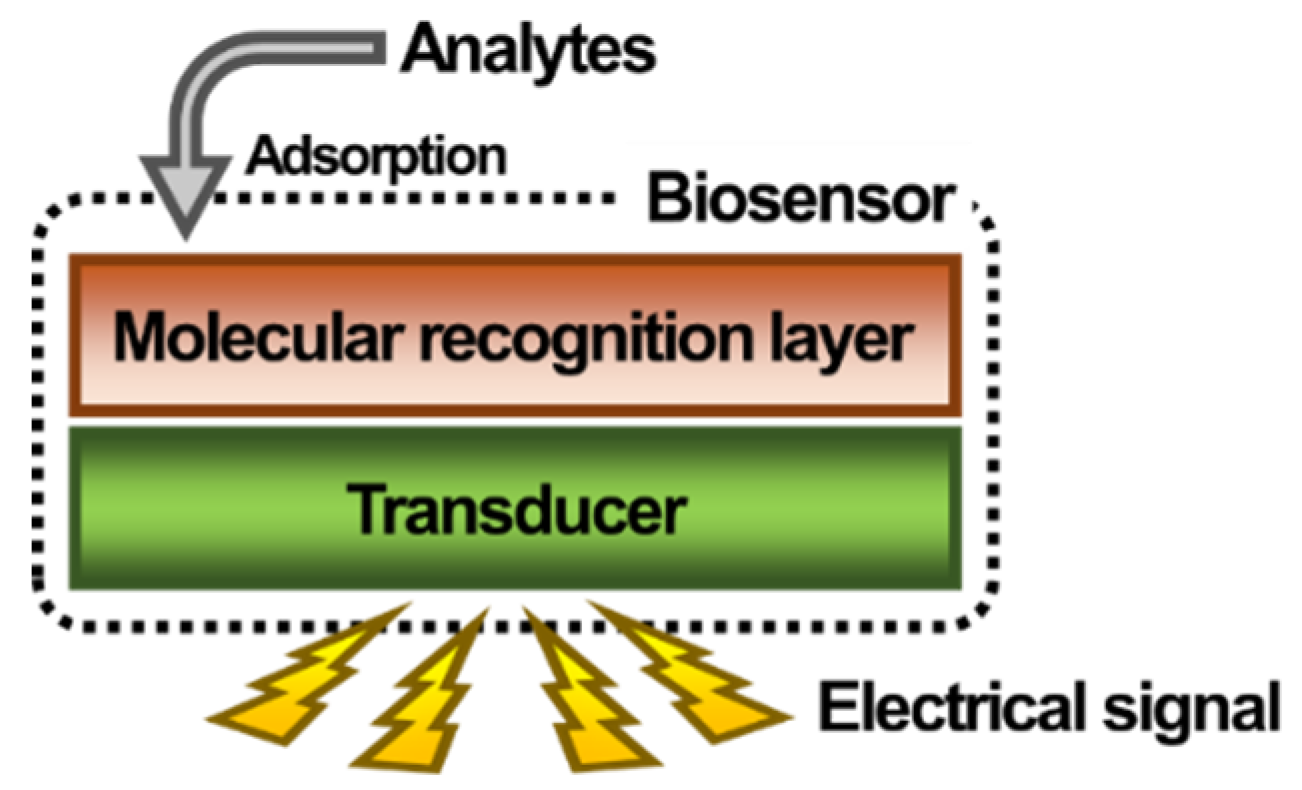
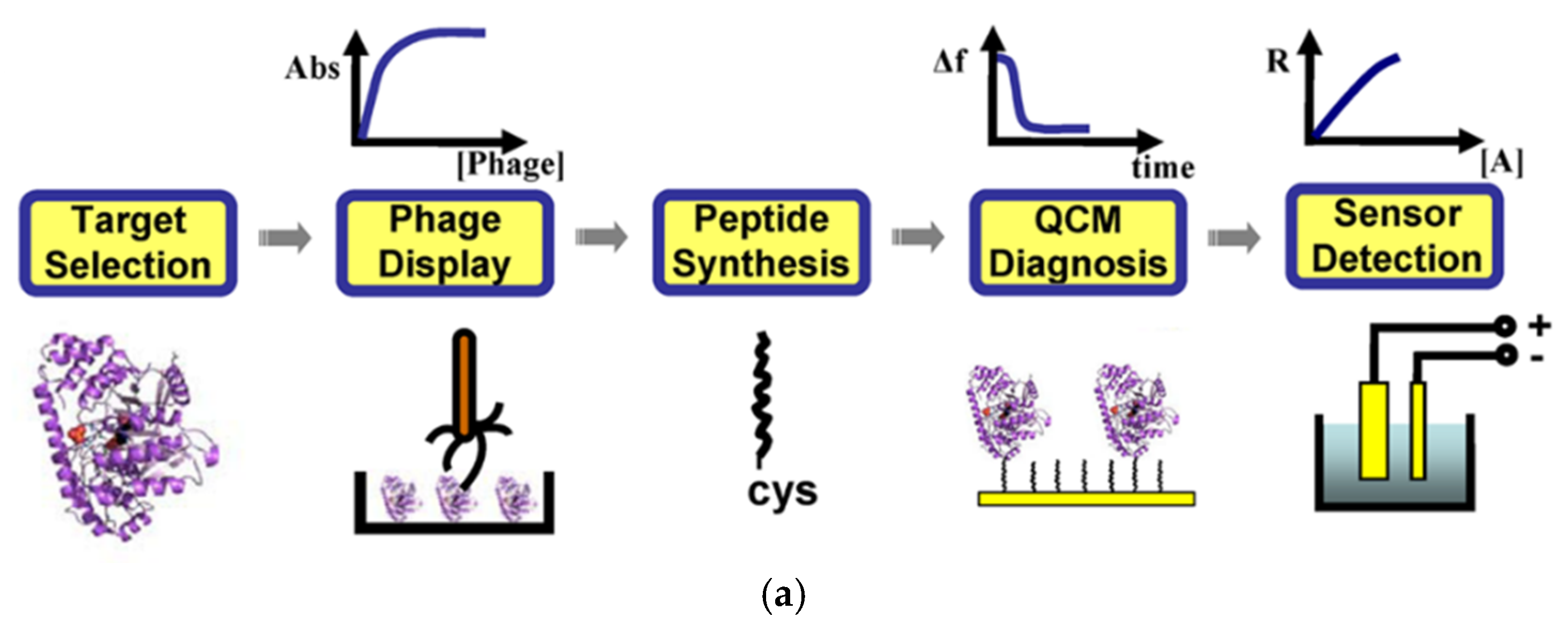
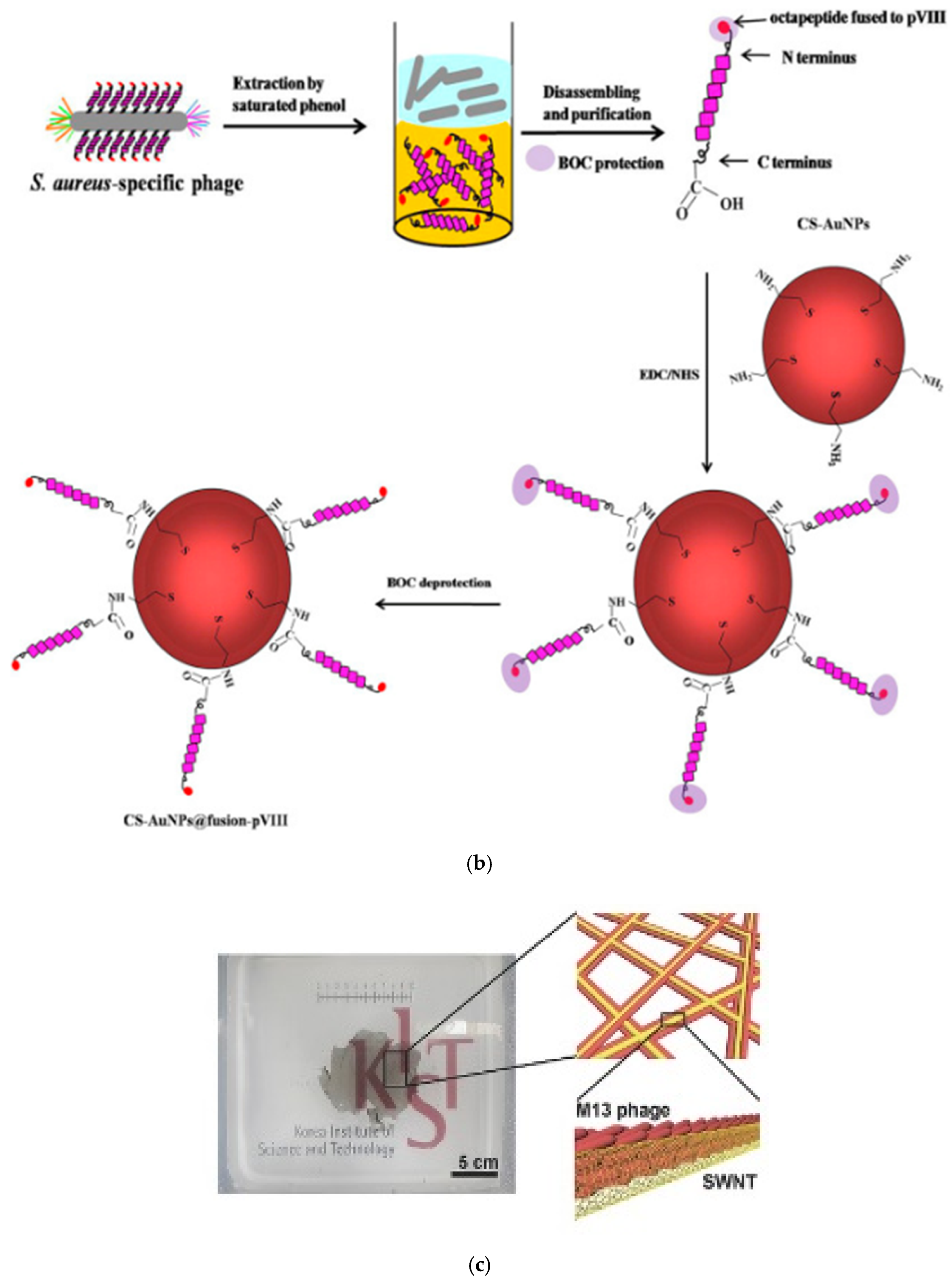
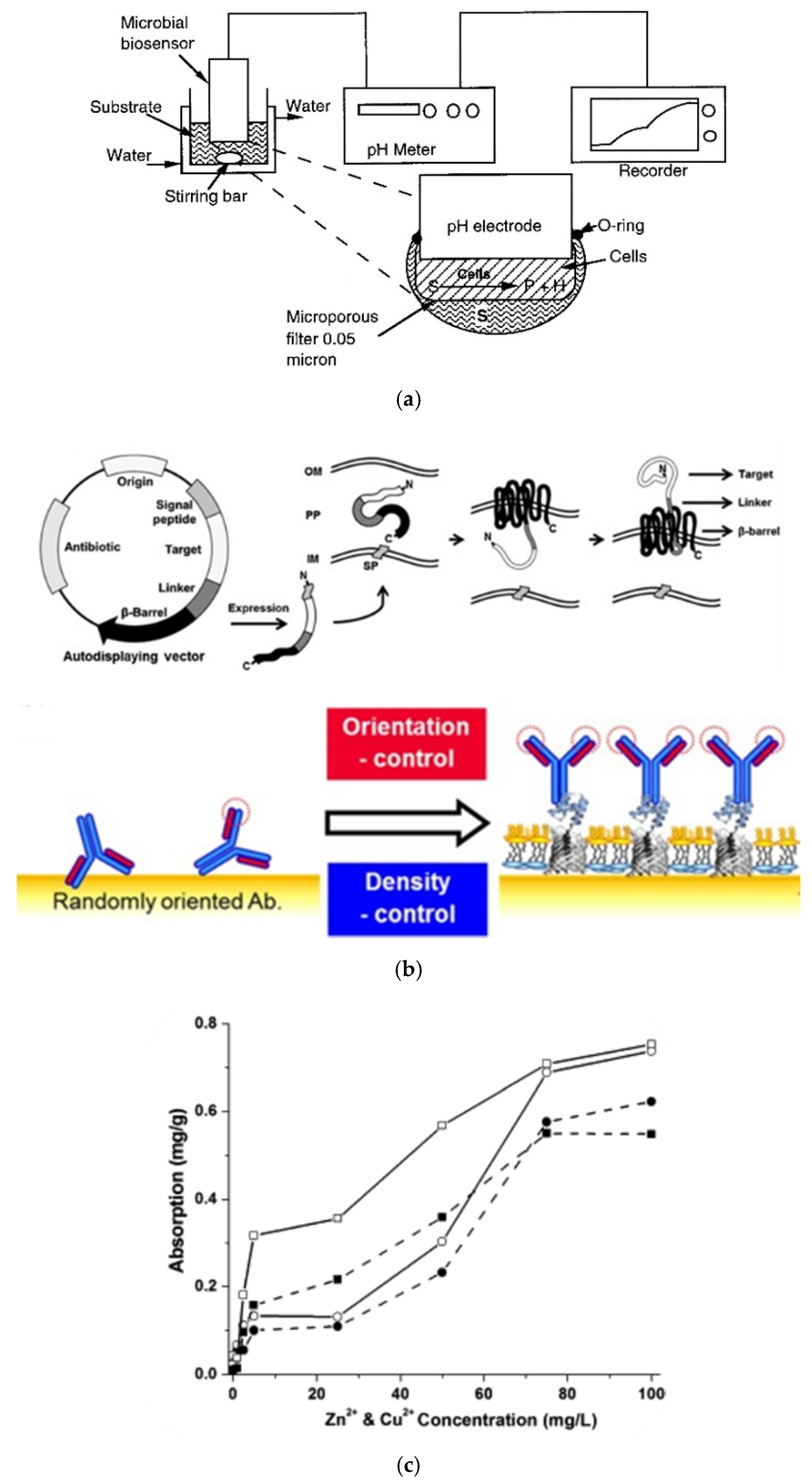
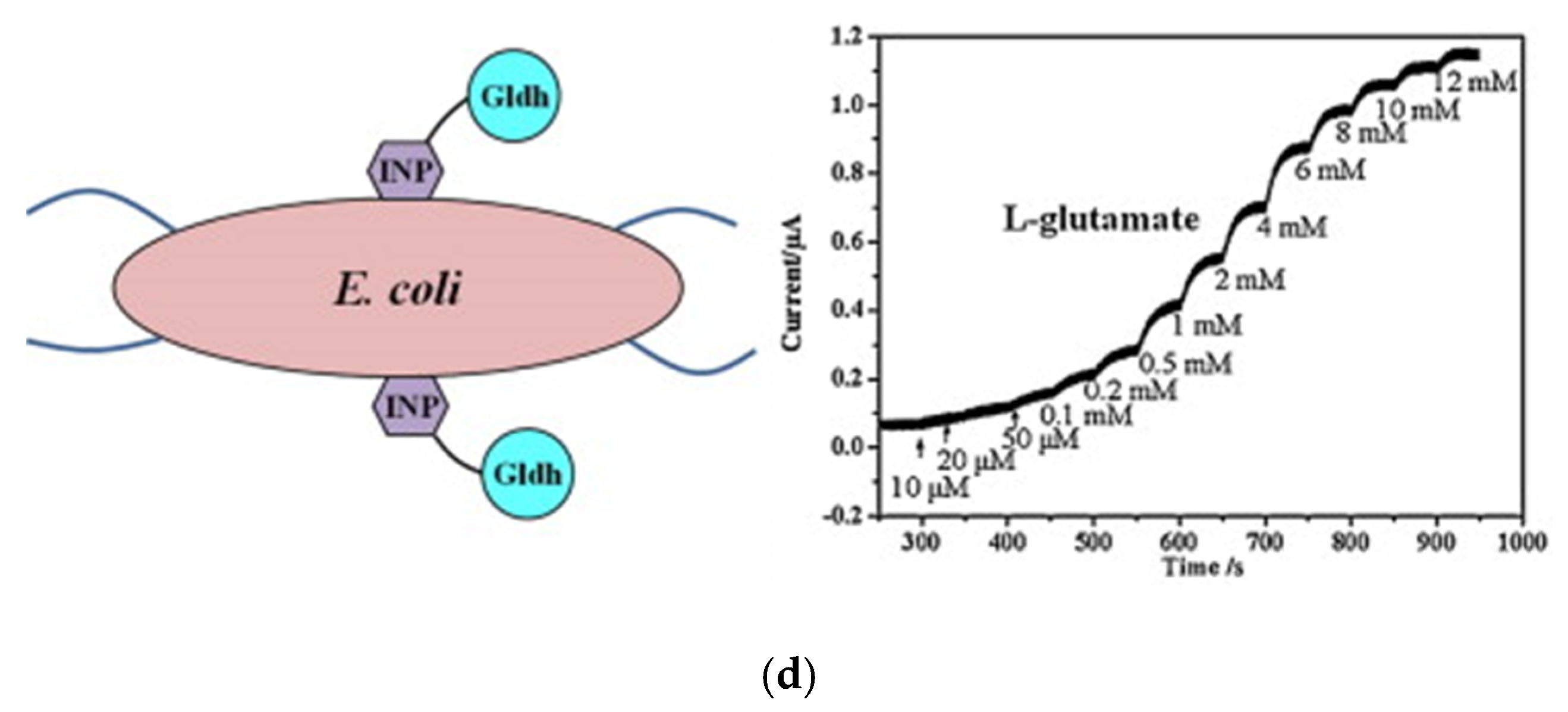
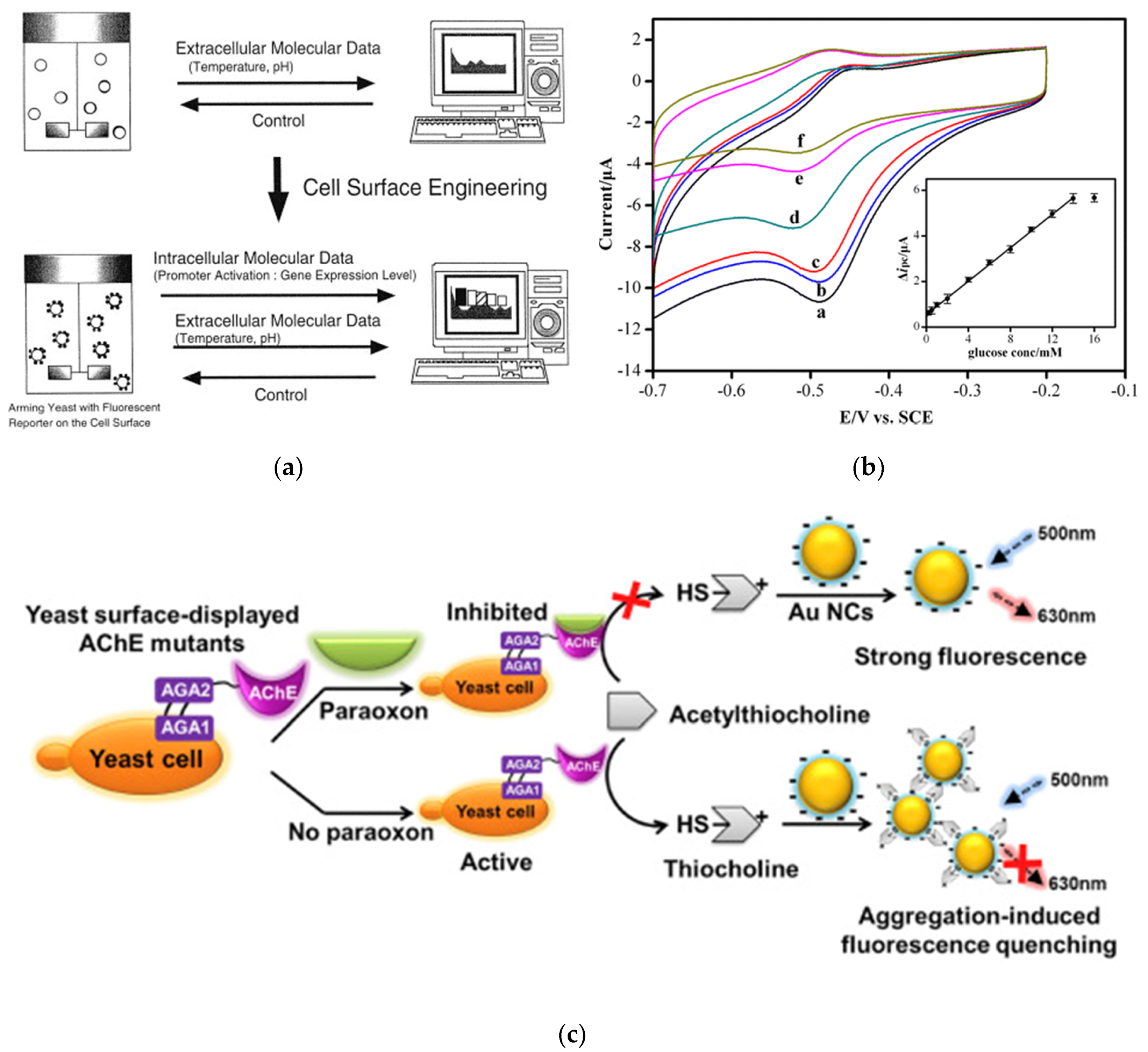
| Type of Library | Affinity Target | Detection Mode | Performance | Assay Time | Ref. |
|---|---|---|---|---|---|
| Peptide | Troponin I | QCM | Sensitivity: 18 Hz/(μg/mL) LOD: 0.11 μg/mL | - | [38] |
| EIS | Sensitivity: 0.3 impedance/(μg/mL) LOD: 0.34 μg/mL | 1 h | |||
| Aminotransferase | QCM | Sensitivity: 8.9 Hz/(μg/mL) LOD: 60 ng/mL | - | [39] | |
| EIS | Sensitivity: 142 impedance %/(μg/mL) LOD: 92 ng/mL | 1 h | |||
| S. aureus | Colorimetry | LOD: 19 CFU/mL | 30 min | [40] | |
| Mouse EEG signal | EIS | Contact impedance: 7.4 kΩ | - | [41] | |
| Glucose | Electrochemistry | Sensitivity: 107 μA/mM∙cm2 LOD: 10 μM | <10 s | [42] | |
| β-galactosidase | QCM | Kd = 1.7 nM | 100 s | [43] | |
| scFv | L. monocytogenes | SPR | LOD: 2 × 106 cfu/mL | - | [44] |
| Type of Target | Displayed Target | Display System | Detection Mode | Analyte | Performance | Assay Time | Ref |
|---|---|---|---|---|---|---|---|
| Enzyme | OPH | Lpp-OmpA | Potentiometry | Paraoxon | LOD: 2 μm | 10 min | [62] |
| Methyl parathion | LOD: 2 μM | ||||||
| Diazinon | LOD, diazinon: 5 μM | ||||||
| INP | Amperometry | Paraoxon | LOD: 9.0 nM | 5 s | [63] | ||
| Parathion | LOD: 10.0 nM | ||||||
| Methyl parathion | LOD: 15 nM | ||||||
| GDH | Amperometry | Glucose | LOD: 4 μM | 2 s | [64] | ||
| GluDH | Amperometry | Glutamate | LOD: 2 μM | - | [65] | ||
| Laccase | inaQ-N | Voltammetry | Catechol | LOD: 0.1 μM Linear range: 0.5–300 μM | - | [66] | |
| Affinity peptide or protein | GBP | FadL | SPR | Biotinylated HRP | 0.62 % SPR angle change | 20 min | [67] |
| cSA | OprF | ||||||
| ZBP | OmpC | Fluorescence | Zn2+ | 0.74 mg/g adsorption | 4 h | [68] | |
| CBP | Cu2+ | 0.75 mg/g adsorption | |||||
| Z-domain | AIDA-I | SPR | myoglobin | 10-fold improved LOD | 1 h | [69] | |
| CRP | 5-fold improved cut-off value | 40 min | [70] | ||||
| CRP | 100-fold improved LOD | 35 min | [71] | ||||
| hIgG | 10-fold improved LOD | 40 min | [72] | ||||
| affibody | ABP | SPR | TNF-α | Kd: 0.77 nM | 20 min | [73] | |
| SPR | ErbB3 | Kd: 0.7 nM | 11 min | [74] |
| Displayed Target | Detection Mode | Analyte | Performance | Assay Time | Ref |
|---|---|---|---|---|---|
| GFP | Fluorescence | Glucose | Available for monitoring the presence of analyte | - | [95] |
| GFP, BFP | Glucose | - | [96] | ||
| ECFP, EYFP | Phosphate, ammonium ion | - | [97] | ||
| EGFP | Protein expression | Simultaneous displaying for protein expression monitoring | - | [98] | |
| GOx | Voltammetry | Glucose | LOD: 0.05 mM Linear range: 0.1–14 mM | 20 s | [99] |
| AChE | Spectrophotometry | Paraoxon | LOD: 0.49 nM Linear range: 1.8 nM–36.3 μM | 15 min | [100] |
| Parathion | LOD: 12.8 nM Linear range: 17 nm–34.4 μM | ||||
| Fluorescence | Paraoxon | LOD: 0.033 fM Linear range: 0.1 fM–0.1 nM | 1.5 h | [101] |
© 2020 by the author. Licensee MDPI, Basel, Switzerland. This article is an open access article distributed under the terms and conditions of the Creative Commons Attribution (CC BY) license (http://creativecommons.org/licenses/by/4.0/).
Share and Cite
Park, M. Surface Display Technology for Biosensor Applications: A Review. Sensors 2020, 20, 2775. https://doi.org/10.3390/s20102775
Park M. Surface Display Technology for Biosensor Applications: A Review. Sensors. 2020; 20(10):2775. https://doi.org/10.3390/s20102775
Chicago/Turabian StylePark, Min. 2020. "Surface Display Technology for Biosensor Applications: A Review" Sensors 20, no. 10: 2775. https://doi.org/10.3390/s20102775
APA StylePark, M. (2020). Surface Display Technology for Biosensor Applications: A Review. Sensors, 20(10), 2775. https://doi.org/10.3390/s20102775





